3. European Transport Simulator (ETS)
3.1. ETS Documentation
This page contains useful information on the European Transport Simulator (ETS) including documentation, description of the pre and post-processing tools used with ETS as well as instructions on how to use ETS and tools on the EUROfusion Gateway.
3.1.1. Configuration of the ETS-5 workflow in Kepler
ETS-5 uses CPO for actor integration in Kepler and as input data to the workflow. This means that the user environment needs to be set up as ITM environment.
To do so login on the EUROfusion Gateway and type the following commands:
module purge
module load cineca
module load itmenv/ETS_4.10b.10_v5.7.0
source $ITMSCRIPTDIR/ITMv2.sh jet
export ITM_KEPLER_DIR=$ITMWORK/my_keplers
export _JAVA_OPTIONS="-Xss20m -Xms4g -Xmx8g -Dsun.java2d.xrender=false"
The command ‘module load itmenv/ETS…’ loads the itmenv environment and in particular in the case above the ETS / Kepler version 5.7.0 To load a different version just change the number e.g. v5.5.0
The $ITMSCRIPTDIR/ITMv2.sh JET command will set up your local database folder to ‘JET’. This means that any simulation done with ETS will be saved in the JET folder (even if you are simulating TCV!!). If you would like to simulate any other Tokamak, type again the command and change JET with e.g. AUG.
The remaining commands are JAVA options for running Kepler and setting of MPI useful for running parallel actors.
If it is the first time you run ETS then you will need to install your first ‘dressed’ Kepler version which corresponds to Kepler with all the WPCD actors embedded in it.
This can be done by executing the following command
install_kepler.sh ets_v570 trunk/ETS_4.10b.10_v5.7.0/central "dressed central kepler v5.7.0"
switch_to_kepler.sh ets_v570
For loading the Workflow+tools (import data, postprocessing):
svn co https://gforge-next.eufus.eu/svn/keplerworkflows/tags/ETS_4.10b.10_v5.7.0
The above command requires enabled access to GFORGE (if you are a ‘simple’ user you might need to apply for access to GFORGE). Typing the command above will check out and store the ETS_worflow.xml and useful python scripts in the directory from where it is issued.
Plotting routines such as kplots can be found under
>cd $KEPLER
You are now ready to start ETS!!
The latest version of ETS-5 is v5.5.0 (09/12/2019)
To launch Kepler and load the ETS-5 workflow just type
>kepler.sh
or if you like to see the the log messages printed on the scree while ETS runs
>kepler.sh -nolog
Once the Kepler canvas opens, chose the option ‘load workflow’ from the File menu and select the workflow you would like to load. The recommendation is to use the ETS workflow released with the version release procedure and then upload your parameter settings via the parameter file. See the option - running ETS with autoGui
A video showing how to run and set up ETS-5 can be viewed here
3.1.2. ETS releases
ETS release 5.5.0 is installed on the Gateway.
Quick installation instructions (to update your environment) are available here (password protected areas):
https://portal.eufus.eu/twiki/bin/view/Main/Installation_of_latest_kepler_release
Detailed instructions are available here:
https://portal.eufus.eu/twiki/bin/view/Main/User_Guide_accessing_JET_data
List of modifications (as compared to the previous release) is available here:
3.2. ETS workflows in KEPLER
The ETS workflow is used for 1-D transport simulation of a tokamak core plasma.
ETS workflows in KEPLER:
use actors and composite actors from the WPCD / IMAS fusion library
complex, but clearly structured workflow, which offers user friendly interface for configuring the simulation
allow for easy modifications (connecting new modules, or reconnecting parts of the workflow) through an easy graphical interface
provide users with all updates through the version control system
still in active development tool (ETS-6)
Starting the workflow: If you have the workflow already installed, there are several ways to execute it:
For execution via kepler GUI:
>kepler.sh workflow_path/workflow_name.xml
for executution via autoGui
>autoGui
once the GUI opens select load workflow after which a parameter file can be loaded. You can create a parameter file by loading the standard workflow released with the Kepler version and then chosing the option from the top menu ‘save parameter file’. The use of autoGui is strongly recommanded as worklows are large xml files while parameter files are small and do not take all your disk space. Moreover parameter files can be loaded in any version of ETS-5 by opening the standard workflow included in the release.
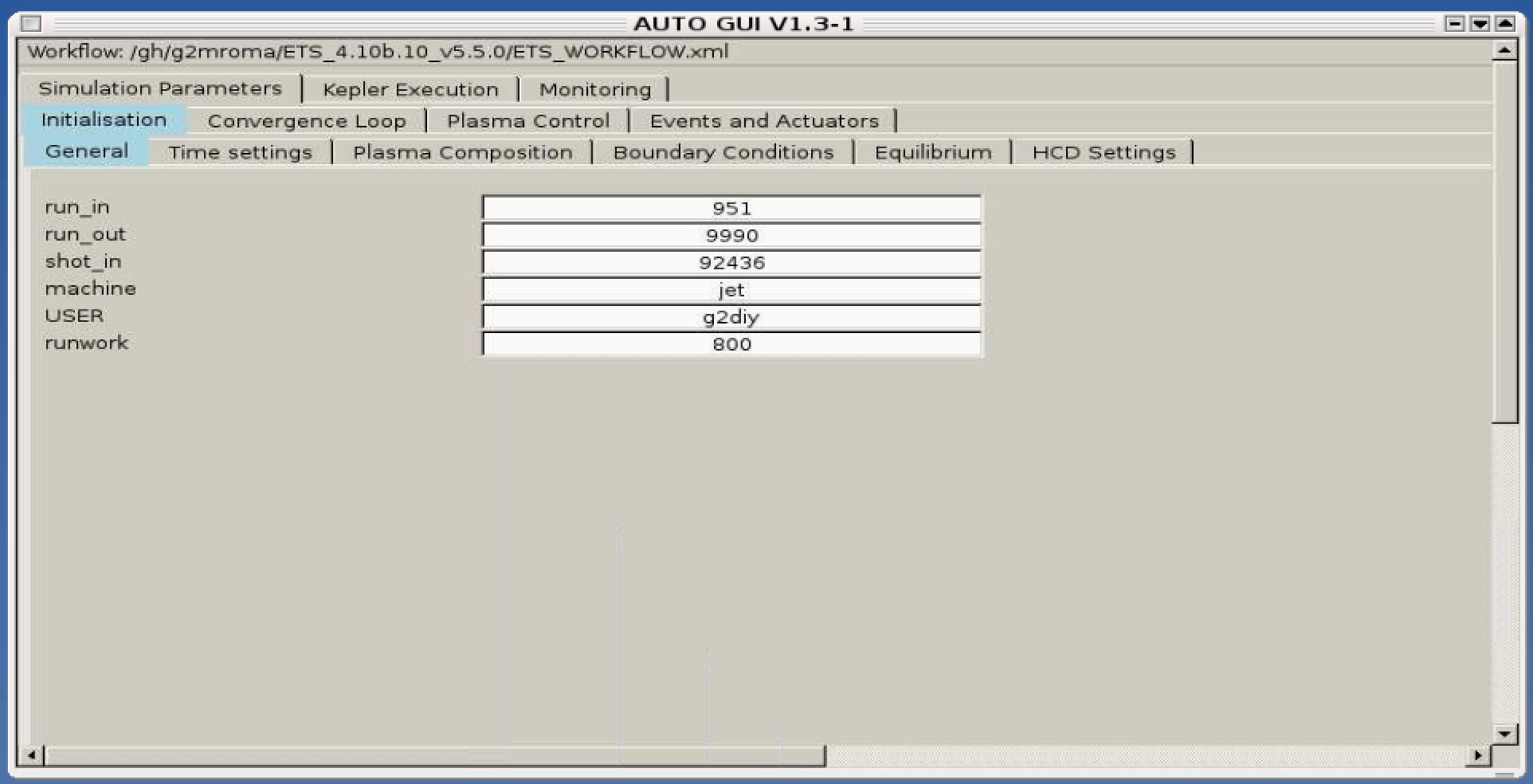
3.2.1. Configuring the ETS run
3.2.1.1. Workflow parameters
3.2.1.1.1. General Parameters
USER - your userid
MACHINE - machine name (database name) for which comutations are done
SHOT_IN - input shot number
RUN_IN - input run number
RUN_OUT - output run number
RUNWORK - work directory number (typically 800)
3.2.1.1.2. Time resolution
Start and End time:
TBEGIN - Computations start time
TEND - Computations end time
3.2.1.1.3. Transport
NRHO - number of radial points for transport equations
3.2.1.1.4. Equilibrium
NPSI - number of points for equilibrium 1-D arrays
NEQ_DIM1 - number of points for equilibrium 2-D arrays, first index
NEQ_DIM2 - number of points for equilibrium 2-D arrays, second index
NEQ_MAX_NPOINTS - maximum number of points for equilibrium boundary
3.2.1.1.5. Numerics
NUMERICAL_SOLVER - choice of the numerics solving transport equations (RECOMENDED SELECTION: 3 or 4)
EXPLICIT HYPER DIFFUSIVITY - Constant diffusivity used in the stabilization scheme needed to deal with stiff transport models
IMPLICIT HYPER DIFFUSIVITY - Same as above used in the implicit part of the solver
MINIMUM TIME STEP - Minimum time step allowed in the transport solver
MAXIMUM TIME STEP - Maximum time step allowed in the transport solver
3.2.1.1.6. Equilibrium
NPSI - number of points for equilibrium 1-D arrays
NEQ_DIM1 - number of points for equilibrium 2-D arrays, first index
NEQ_DIM2 - number of points for equilibrium 2-D arrays, second index
NEQ_MAX_NPOINTS - maximum number of points for equilibrium boundary

Time step:
right click on the box BEFORE THE TIME EVOLUTION
select Configure actor
TAU :specify value of the time step in [s]
TAU_OUT : specify value of the output time interval in [s]
Commit

3.2.1.2. Ion, Impurity and Neutral Composition
Before starting the run you need to define types of main ions, impurity (optional) and neutrals (optional) to be included in simulations.
To define plasma composition:
right click on the box BEFORE THE TIME EVOLUTION
select Configure actor
choose one of modes for setting Run_compositions
from_input_CPO - will pick up the COMPOSITIONS structure of the COREPROF CPO saved to the input shot;
configure_manually - will force the composition from the values specified below
specify values of atomic mass (AMN_ion), nuclear charge ( ZN_ion ) and charge ( Z_ion , from the first ion to the last [1:NION] , separated by commas
(optional) specify values of atomic mass ( AMN_imp ), nuclear charge ( ZN_imp ) and maximal ionization state ( max_Z_imp ) for impurity ions, from the first to the last [1:NIMP] , separated by commas
(optional)for neutrals activate, by switchen them to ON, the types which shall be followed by neutral solver
press Commit
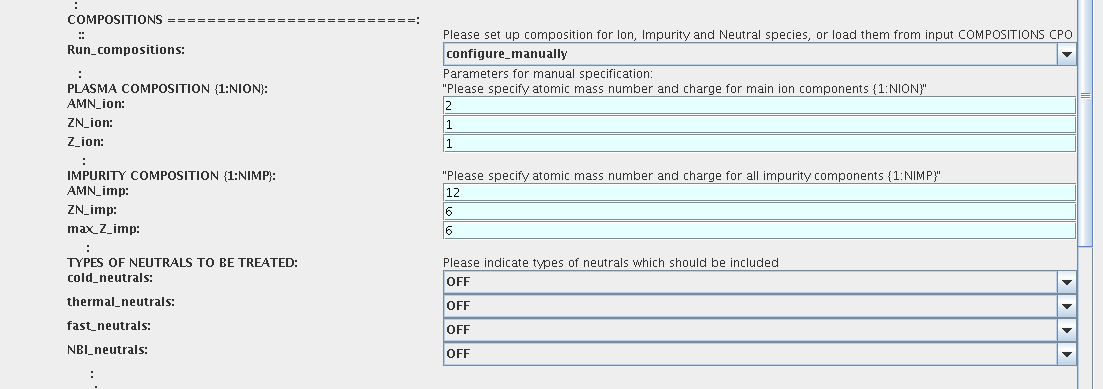
3.2.1.3. Equations to be solved and boundary conditions
3.2.1.3.1. Main Plasma
Before starting the run you need to select the type and value of the boundary conditions for all equations. Please note that the value should correspond to the type. All equations allow for following types of boundary conditions:
OFF - equation is not solved, initial profiles will be kept for whole run
value - edge value should be specified
gradient - edge gradient should be specified
scale_length - edge scale length should be specified
generic - generic form: a1*y´ + a2*y = a3 of the boundary condition is assumed, 3 coefficients (a1, a2, a3) should be provided
value_from_input_CPO - equation is solved, edge value evolution will be red from input shot
profile_from_input_CPO - equation is not solved, profile evolution will be red from input shot
The particular equation will be activated if the boundary condition type for it is other than OFF
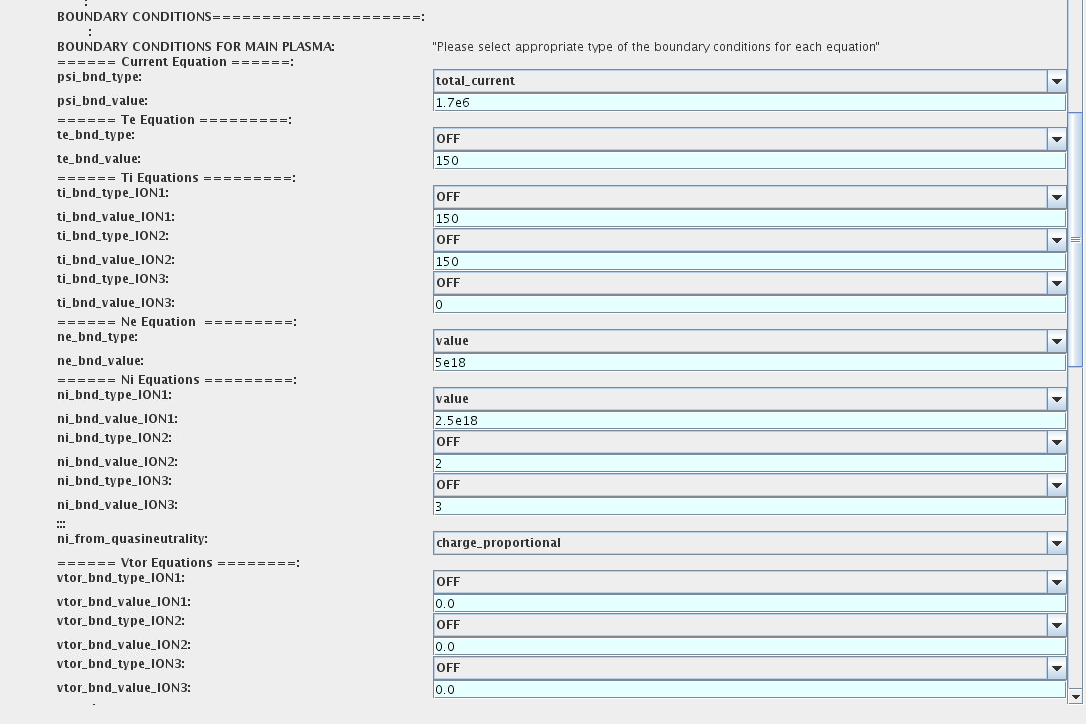
To set up boundary conditions:
right click on the box BEFORE THE TIME EVOLUTION
select Configure actor
select appropriate boundary condition for each equation
specify values for boundary conditions corresponding to the type and to the ion component
Commit
The workflow will not allow the user all particle components (ions[1:NION]+electrons) to be run predictively. At least one of them shall be set to OFF (this component will be computed from quasi-neutrality condition).
!!! If electron density is solved, all ions with ni_bnd_type=OFF will be computed from the quasineutrality condition and scaled proportional to specified ni_bnd_value or inversely proportional to their charge, charge_proportional. This is defined by option: ni_from_quasineutrality.
3.2.1.3.2. Impurity
You can set up the boundary conditions for impurity ions in a similar way as for main ions. !!! Note, that at the moment only types: OFF; value and value_from_input_CPO are accepter by impurity solver.
To set up boundary conditions:
right click on the box BEFORE THE TIME EVOLUTION
select Configure actor
select appropriate boundary condition for each impurity species ( OFF-equation is not solved)
specify values for boundary density of each impurity component [1:MAX_Z_IMP], separated by commas
Commit

Interface for impurity boundary condition has additional option, coronal_distribution, that allow to preset the edge values or entire profiles of individual ionization states from coronal distribution. In tis case only single value is required to be specified for each impurity boundary value. The options are:
OFF - the boundary values for impurity densities will be as they are specified above;
boundary_conditions - the boundary densities will be renormalized with corona, using the first element from above as a total density
boundary_conditions_and_profiles - the boundary densities and starting profiles will be renormalized with corona, using the first element from above as a total density
3.2.1.3.3. Neutrals
Note, that ALL values should be specified in the order: {1, 2, 3 …NION, 1, 2, 3, …NIMP}
To set up boundary conditions:
right click on the box BEFORE THE TIME EVOLUTION
select Configure actor
select appropriate boundary condition for each neutral species (OFF-equation is not solved)
specify values for boundary density and temperature of each neutral component [1, 2, 3 …NION, 1, 2, 3, …NIMP], separated by commas
Commit

3.2.1.3.4. Input profiles interpolation
You are going to start the ETS run from some input shot, which might contain some conflicting rho grids saved to different CPOs. Thus there is a choice for the user to decide on the grid on which the starting profiles should be load by the worflow,
Interpolation_of_input_profiles.
To define the interpolation grid select:
on_RHO_TOR_grid - interpolate input profiles based on the grid specyfied in [m];
on_RHO_TOR_NORM_grid - interpolate input profiles based on normalised rho grid [0:1]

3.2.1.4. Convergence loop
ETS updates input from different physics actors in a sequence, which is finished by solving the transport equations. Ther are possible none-linear couplings between different parts of the system. These nonelinearities are treated by the ETS using iterations. The decision to step in time is made by the ETS based on the criteria that the maximum relative deviation of main plasma profiles is lower than some predefined tolerance. There is a number of settings and switches in the ETS that are used by the iterative scheme. To edit them do:
right click on the box CONVERGENCE LOOP
select Configure actor to edit settings
choose your settings
Commit
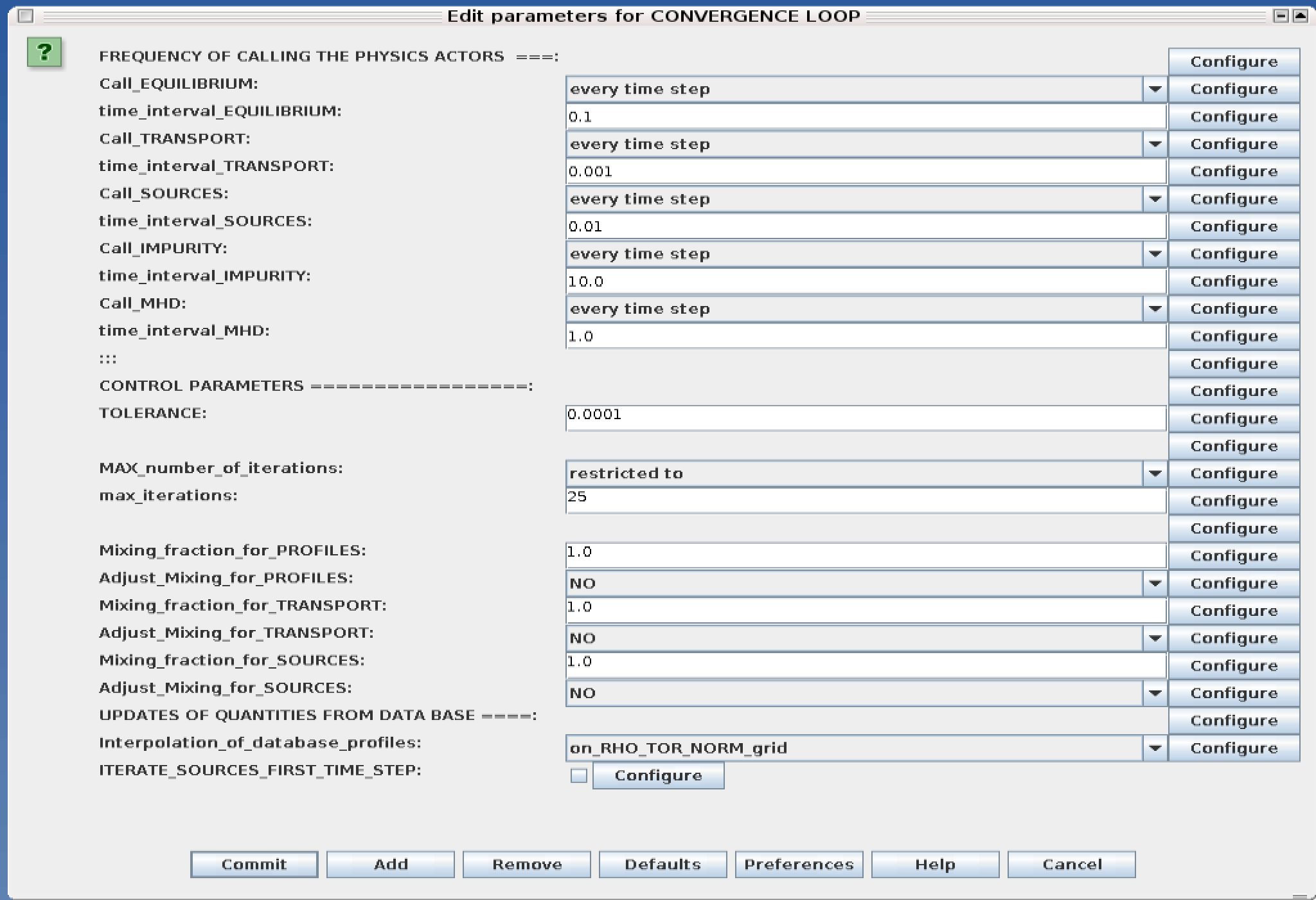
Switches in the field FREQUENCY OF CALLING THE PHYSICS ACTORS define how many times the actors of a certain cathegory (equilibrium, transport, etc.) should be called.
Switches and parameters in the field CONTROL PARAMETERS define how iterations are done
Tolerance - defines the maximum relative error of profiles change compared to previous iteration. If it is achieved the time steping is done.
For highly none-linear case the required precision can be achieved faster by the iterative scheme if only fraction of the new solution is mixed to the previous state. The following scheme is adopted by the ets to reduce none-linearities in profiles, transport coefficients and sources:
Y = (Amix * Y+) + ((1-Amix)*Y-)
where Amix is the mixing fraction You can activate the mixing of profiles, transport coefficient and sources by selecting the corresponding Mixing_fraction_… to be between [0:1] You also can activate the authomatic ajustment of this fraction by selecting: Ajust_Mixing_for_… to YES
3.2.1.5. Equilibrium
3.2.1.5.1. Initialization Settings
Before starting the run you need to set up your initial equlibrium. There are several options to do it: if your input shot contains the consistent equilibrium with all necessary parameters - you can start immediately from it; if your input shot contains the equilibrium but it is not consistent or some parameters are missing you can check it automatically; if your input equilibrium is corrupt or not present - you can define the starting equlinbrium by tree moment description. To select your starting equilibrium please do:
right click on the box BEFORE THE TIME EVOLUTION
select Configure actor to edit settings
Select your settings or specify values
Commit
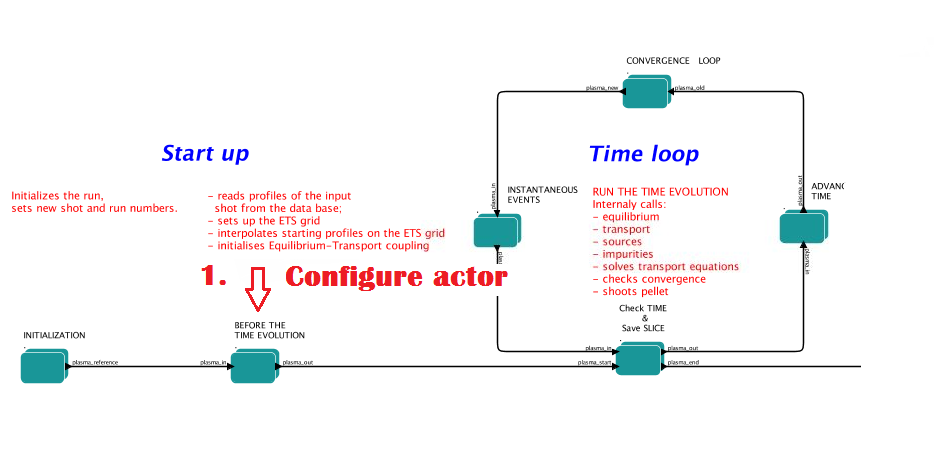
SETTINGS:
Equilibrium_configuration - select configure_manually if you like to specify configuration below; select from_input_CPO if all quantities should be picked up from the input CPO
R0_Machine_characteristic_radius - Characteristic radius of the machine, here B0 is measured [m]
B0_Magnetic_field_at_R0 - Magnetic field measured at the position R0 [T]
RGEO_Major_Radius_of_LCMS_centre - R coordinate of the geometrical centre of the LCMS [m]
ZGEO_Altitude_of_LCMS_centre - Z coordinate of the geometrical centre of the LCMS [m]
Total_plasma_current_IP - plasma current within the LCMS [A]
Minor_radius - minor radius of the LCMS [m]
Elongation - elongation of the LCMS [-]
Triangularity_upper - upper triangularity of the LCMS [-]
Triangularity_lower - lower triangularity of the LCMS [-]
Equilibrium code - select one of available equilibrium solvers to check the consistency between starting equilibrium and current profile; use INTERPRETATIVE if you trust your input data (in this case the check will be ignorred).
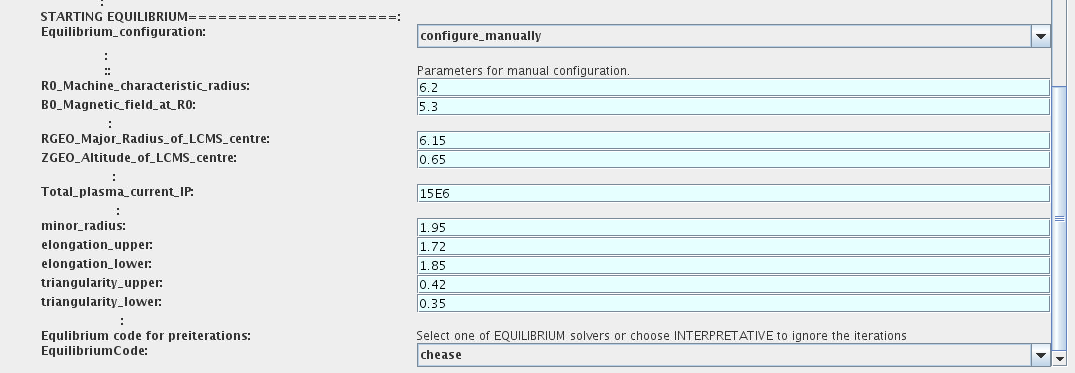
Please note, that different equilibrium solvers might require slightly different input. Thus it is a user responsibility to check that the information inside input shot/run is enough to run selected equilibrium solver.
3.2.1.5.2. Run Settings
There are several equilibrium solvers connected to the ETS. You can select the one of them.Therefore please do:
right click on the box CONVERGENCE LOOP
select Open actor
right click on the box EQUILIBRIUM
select Configure actor to edit settings
choose your equilibrium solver
Commit

INTERPRETATIVE means that the ETS will not update the equilibrium, instead it will be using the initial equilibrium.
Please note, that it is better to select the same code as you used for pre-iterrations. Because outputs of different equilibrium solver are not necessary done with the same resolution. Therefore the routine saving the information to the data base might brake due to uncompatible sizes of some signals.

3.2.1.6. Transport
The settings for TRANSPORT can be done inside the CONVERGENCE LOOP composite actor. Therefore please do:
right click on the box CONVERGENCE LOOP
select Open actor
right click on the box TRANSPORT
select Configure actor to edit settings
choose your settings
press Commit

3.2.1.6.1. Transport models
ETS constructs the total transport coefficients from the combination of Anomalous transport (model choice), Neoclassical transport (model choice), Database transport (transport coefficients be saved to the input shot) and Background transport (Transport coefficients defined through the GUI interface)
D_tot = D_DB*M_DB + D_AN*M_AN + D_NC*M_NC + D_BG*M_BG
You should choose from the list of evailable models in each cathegory or switch it OFF
Individual multipliers for all channels shall be specified on the lower level through the code parameters of Transport Combiner

3.2.1.6.2. Background transport
You can add the constant background level for each coefficient (ion and impurity coefficients are expected to be the strings of [1:NION] and [1:NIMP] elements respectively, separated by commas)
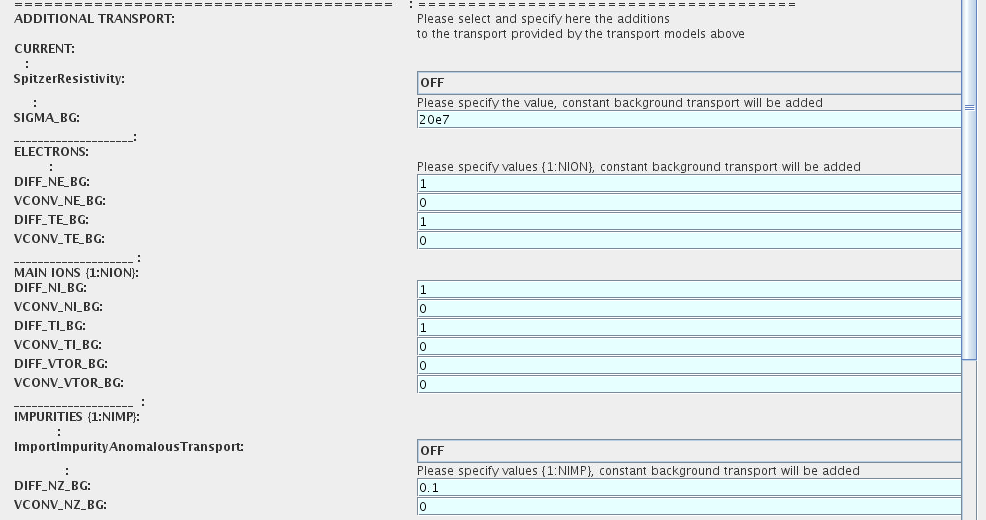
3.2.1.6.3. Edge transport barrier
In this section you can artificially supress the transport outside of specified RHO_TOR_NORM_ETB. Total transport coefficients for all transport channels (ne, ni, nz, Te, Ti,…) will be reduced to constant values specified below (ion and impurity coefficients are expected to be the strings [1:NION] and [1:NIMP] respectively)

3.2.1.6.4. Total transport coefficients
The fine tuning of of transport coefficients can be done through editing the XML code parameters of the transport combiner actor:
In Outline browse for transportcombiner
select Configure actor
click Edit Code Parameters
If you select OFF contributions from all transport models to this channel will be nullified;
If you select Multipliers_for_contributions_from the transport channel will be activated, and the total transport coefficient will be combined from active tranport models. You gust need to specify multiplier against each channel;
For convective velocity there is an additional option V_over_D_ratio_for_contributions_from. With this option selected the combiner will ignore the convective components provided by transport models. The convective velocity will be determined from the diffusion coefficient by applying fixed V/D ratio ( for inward pinch the values should be negative! ).
Save and exit
Commit
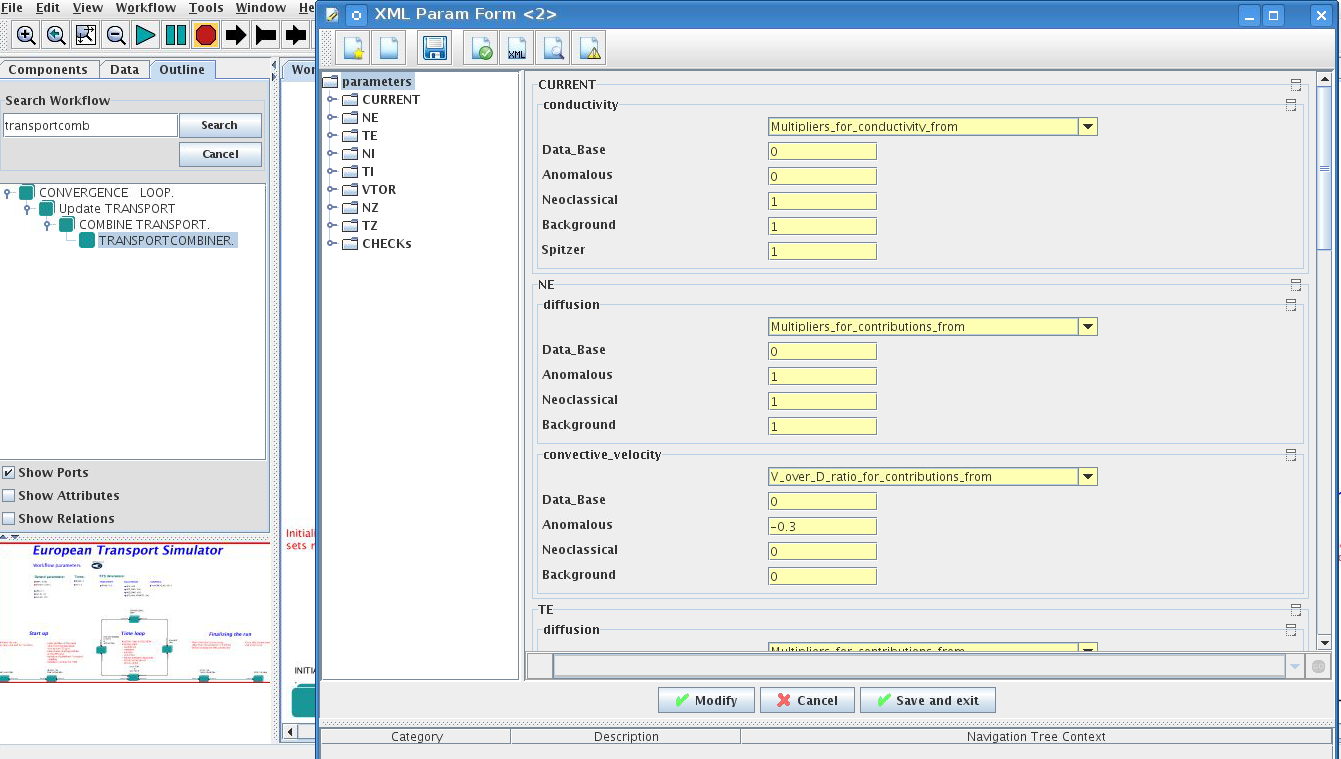
3.2.1.7. MHD
The settings for MHD type of events can be done inside the CONVERGENCE LOOP composite actor. Therefore please do:
right click on the box CONVERGENCE LOOP
select Open actor
right click on the box MHD
select Configure actor to edit settings
choose your settings
Commit

At the moment ETS allows only for NTM to be activated.
User can ajust the following NTM settings:
NTM – ON means that ETS will add the NTM driven transport to the total transport coefficient; OFF -ignored
NTMTransportMultiplier – the transport contrinution from NTM will be multiplied with this value
Onset_NTM_time - activation time for the NTM mode
Onset_NTM_width - starting width of the mode
m_NTM_poloidal_number
n_NTM_toroidal_number
NTM_phase
NTM_frequency

3.2.1.8. Sources and impurity
The settings for SOURCES AND IMPURITY can be done inside the CONVERGENCE LOOP composite actor. Therefore please do:
right click on the box CONVERGENCE LOOP
select Open actor
right click on the box SOURCES AND IMPURITY
select Configure actor to edit settings
choose your settings
Commit

3.2.1.8.1. Analytical & Impurity sources
There is a number of sources developed by WPCD, which are actors or internal routines of the transport solver. You can activate them by selecting ON / OFF in front of corresponding source:
Database Sources – ON - ETS will pick up the evolution of source profiles saved to your input shot/run; OFF -ignored
Ohmic Heating – ON - ETS will compute Ohmic heating internaly; OFF -ignored
Gaussian Sources – ON - ETS will add sources from the Gaussian source actor (you can configure heat and particle deposition profiles by editing the code parameters of the actor); OFF -ignored
Neutral Sources – ON - Fluid neutrals will be solved according to the boundary conditions specified on ¨Before_time_evolution¨ composite actor interface; OFF -ignored
Switch_IMPURITY – ON - Impurity density and radiative sources will be computed; OFF -ignored; INTERPRETATIVE – profiles of impurity density will be read from input shot/run

3.2.1.8.2. HCD sources
There is a number of sources developed by WPCD, that are incorporated by the ETS workflow.
For the HCD sources please activate the type of heating source, by ticking the box in front of it, and select the code to simulate it.
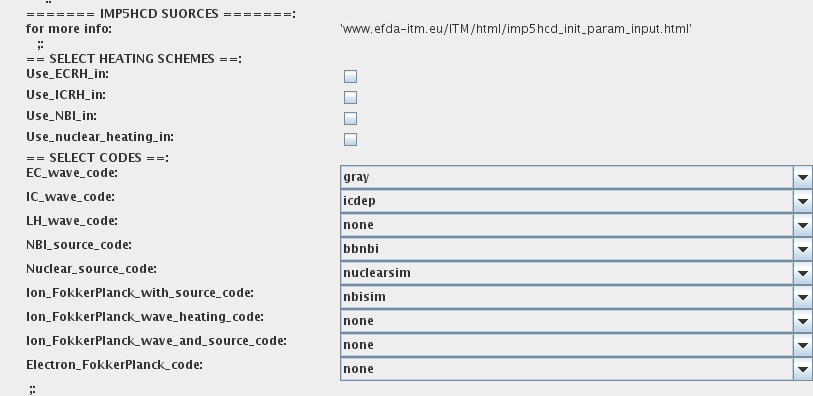
You also need to configure initial HCD settings. Therefore please:
right click on the box BEFORE THE TIME EVOLUTION
select Open Actor
right click on the box SETTINGS FOR HEATING AND CURRENT DRIVE
select Configure actor
edit the stettings
Commit

Please note that settings for NBI are done independent for each PINI. Therefore, for NBI settings, please insert the values separated by commas. The number of the element in the array corresponds to the number of activated PINI. Maximum accepted number of PINIs = 16.
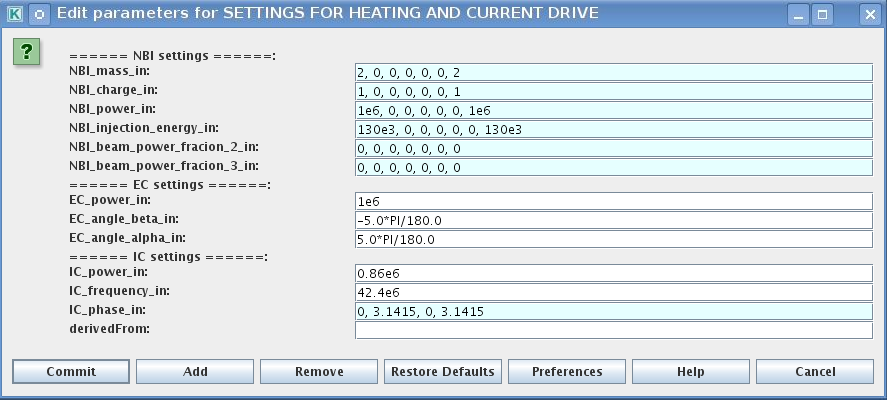
3.2.1.8.3. Power control
You also can activate the power control for the IMP5HCD sources.
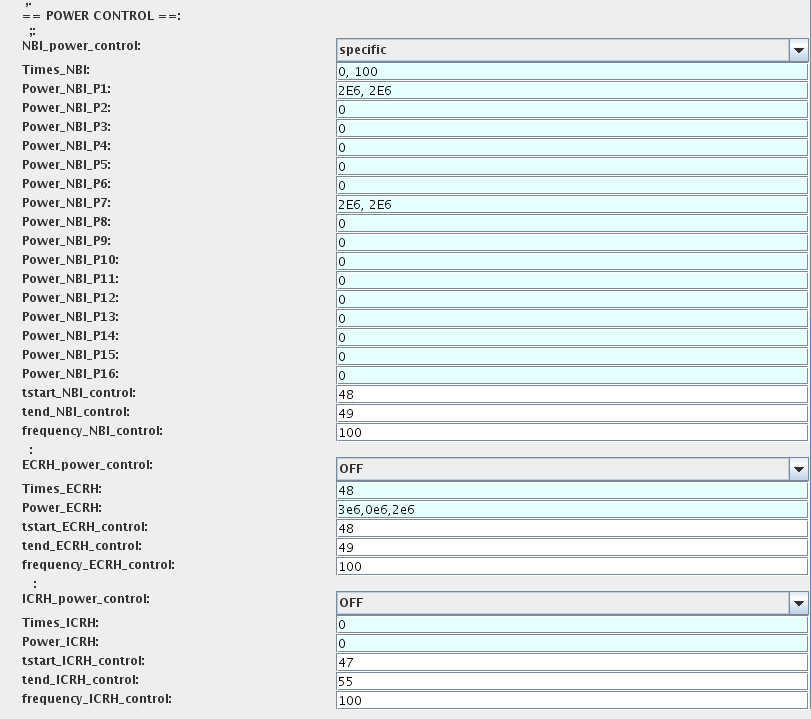
If the POWER_CONTROL is not OFF, there are two modes of operation: specific and frequency
For specific you should specify the time sequence separated by commas and the corresponding power sequence (where first power level corresponds to the first time, second to second and etc.). Linear interpolation will be done between the sequence points. For example: if you give the power sequence = 2e6,4e6,1e6 and times = 0.0, 0.7, 1.5 (s) the delivered power would be:
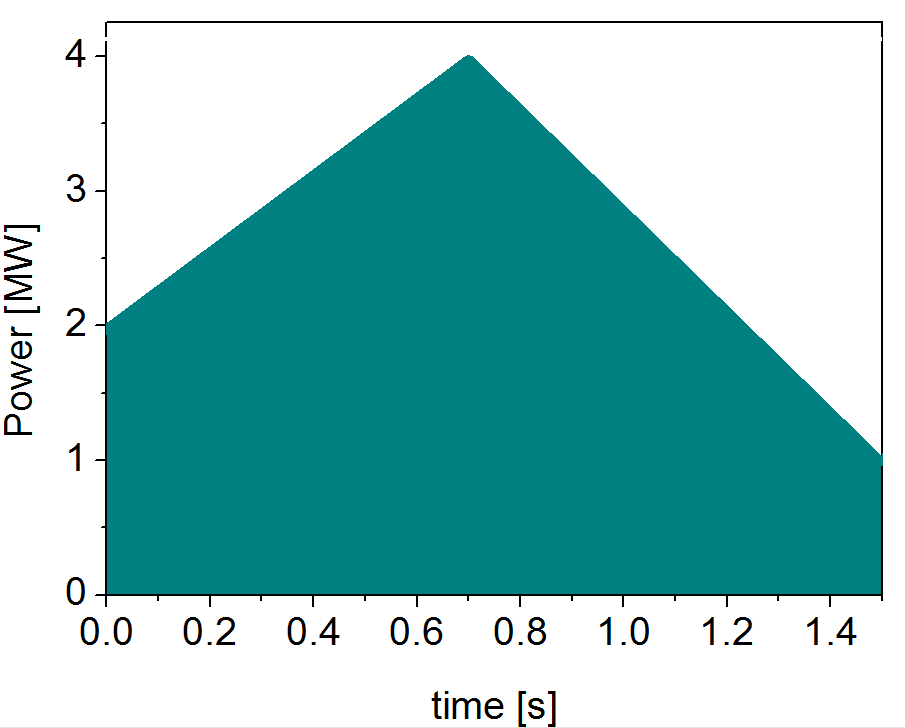
For frequency you should specify the power levels sequence separated by commas, start and end time of the power control and the frequency of switching between these levels. For example: if you give the power sequence = 2e6,4e6,1e6 and frequency = 10 (Hz) tstart = 0.0 (s) tend = 1.5 (s) the delivered power would be:
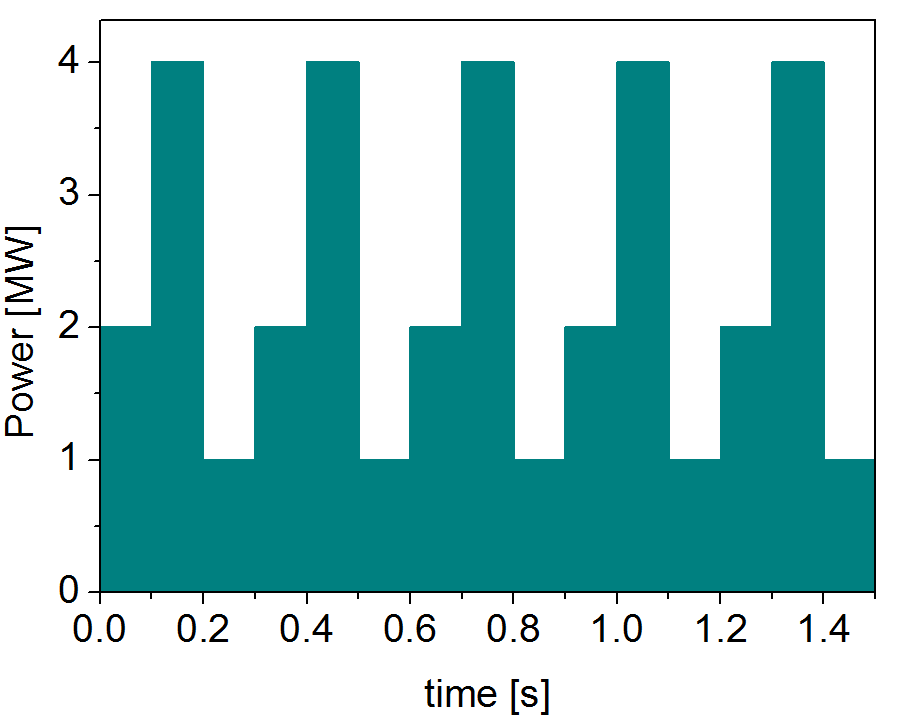
3.2.1.8.4. Total power
Profiles of the total source for each channel are obtained from the the individual contributions (Data Base, Gaussian, Neutrals, Impurity and HCD) as a summ of all activated sources multiplied with coefficients specified on the interface of the composite actor.
S_tot = S_DS*DSM + S_GS*GSM + S_Neu*NeuSM + S_IMP*IMPSM + S_HCD*HCDSM
The fine tuning of of sources can be done through editing the XML code parameters of the source combiner actor:
In the Outline browse for source combiner
select Configure actor
click Edit Code Parameters
If you like the sources to the particular equation being activated - select from_input_CPOs, and then, put the multipliers against each contribution; if you select OFF contributions from all sources to this channel will be nullified.
save and exit
Commit
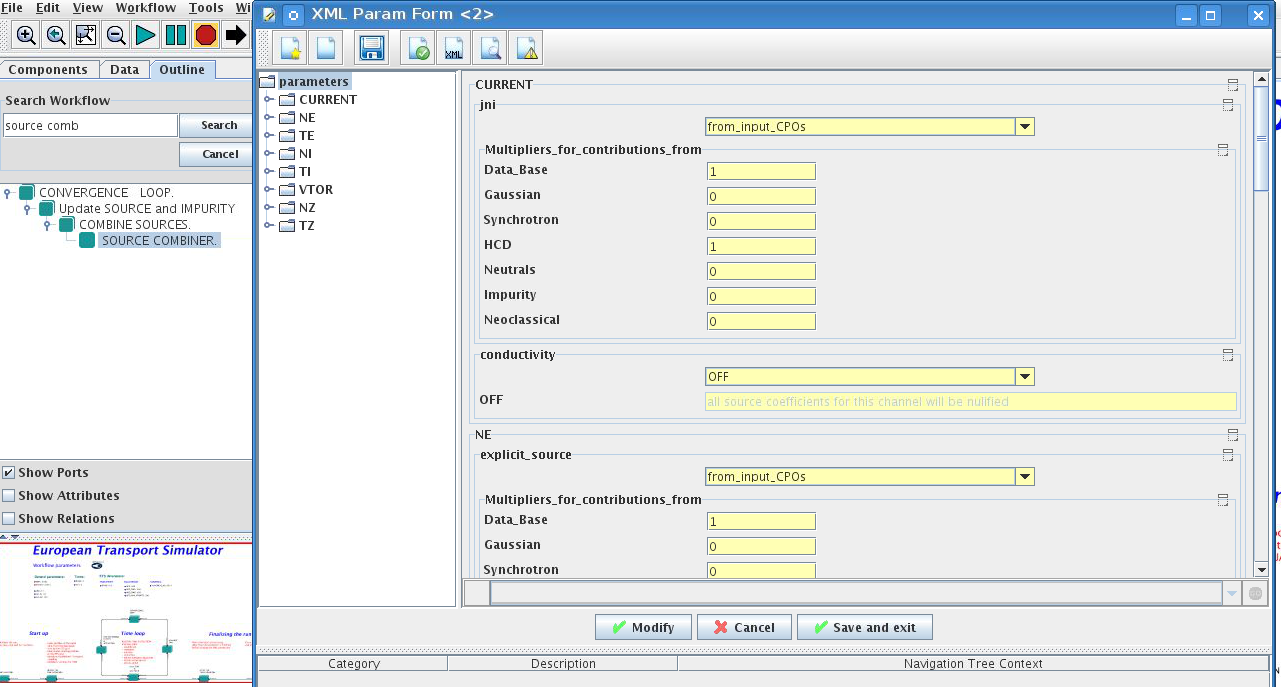
3.2.1.9. Instantaneous events & Actuators
At the moment, user can swith ON and OFF two types of events: PELLET and SAWTOOTH
3.2.1.9.1. Pellet
At the top level of the workflow you can configure times for pellet injection
right click on the box INSTANTANEOUS EVENTS & ACTUATORS
select Configure actor to edit settings
Select Pellet_injection equal ON if you like to use pellet in your simulation
Select mode of operation:
Times_for_pellets equals specific – pellets will be shut at exact times specified in array times_pellet
Times_for_pellets equals frequency – pellets will be shut from tstart_pellet until tend_pellet with a frequency_pellet
Commit
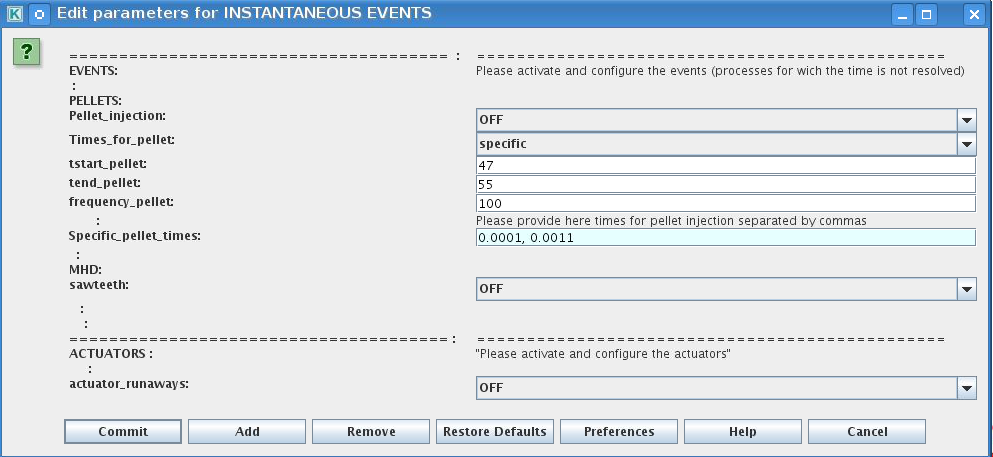
Parameters of individual pellet need to be configured through the code_parameters of the PELLET actor. To access it go to Outline on the right upper corner and open the following:
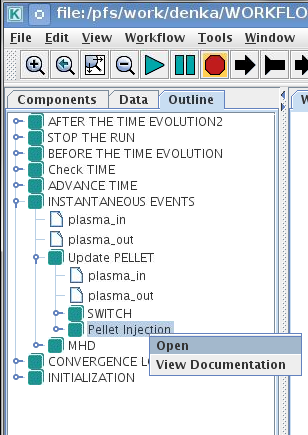
right click on the actor PELLET
select Configure actor
click Edit Code Parameters
edit parameters and click save and exit
Commit
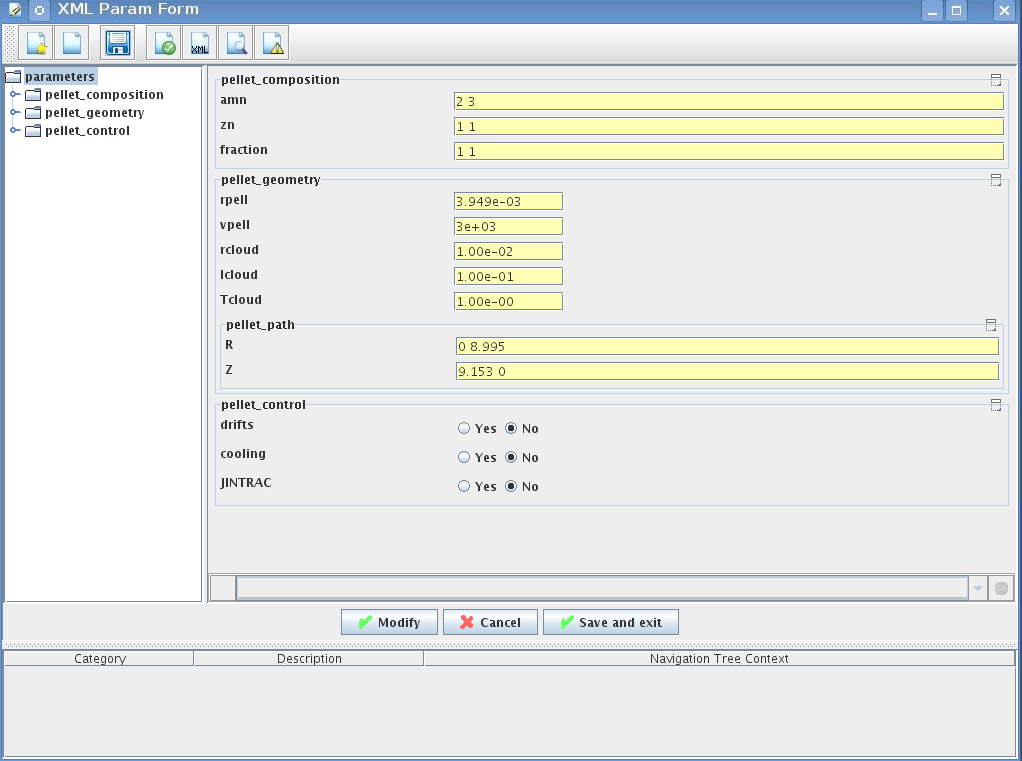
amn – atomic mass number: array of elements separated by space (1:nelements) [-]
zn – nuclear charge: array of elements separated by space (1:nelements) [-]
fraction – fraction of each element in the pellet, based on the number of atoms: array of elements separated by space (1:nelements) [-]
rpell – radius of the pellet [m]
vpell – velocity of the pellet [m/s]
rcloud – radius of the pellet cloud [m], radial extension of the cloud = 2*rp0
lcloud – length of the pellet cloud along the field line [m]
Tcloud – temperature of the pellet cloud [eV]
Pellet path is specified by two points, for which R and Z coordinated should be specified
R – R coordinates of the pivot and second points of the pellet path, separated by space [m]
Z – Z coordinates of the pivot and second points of the pellet path, separated by space [m]
Control switches allow to activate:
drifts - YES - will activate radial displacement of deposition profile, same for all path points
cooling - YES - will activate cooling of the other side of the plasma due to parallel heat transport (essential for large pellets, which might cross the same flux surface twice)
JINTRAC - YES - will provide temperature reduction consistent with the model used in JETTO
3.2.1.9.2. Sawtooth
At the top level of the workflow you can switch ON/OFF possible MHD events
right click on the box INSTANTANEOUS EVENTS & ACTUATORS
select Configure actor to edit settings
Select SAWTOOTH ON if you like to use them in your simulation
Commit
3.2.1.9.3. Actuators
At the top level of the workflow you can switch ON/OFF actuator for Runaway Indicator (Runin) - this is ON by default. It only gives warning messages, and has no effect on the simulation results.
right click on the box INSTANTANEOUS EVENTS & ACTUATORS
select Configure actor to edit settings
Select actuator_runaways OFF if you’d like not to use Runaway Indicator in your simulation
Commit
3.2.1.10. Scenario output
You can summarize the ETS run by activating the output to SCENARIO CPO (as post-processing of the run).
To activate the SCENARIO output:
right click on the box AFTER THE TIME EVOLUTION
select Configure actor
select Generate_SCENARIO_output_from_ETS_run equal YES
Commit
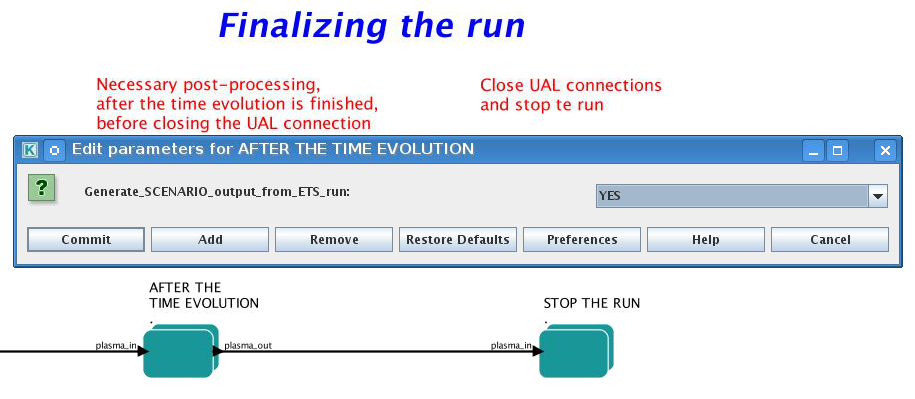
3.2.1.11. Visualization during the run
There is a number tools visualizing the ETS run.
3.2.1.11.1. Multiple Tab Display
The display appeares automaticaly when the ETS workflow is launched. It displays diagnostic text messages from the workflow on following topics:
Input data statement
Iterations to check the initial convergence between EQUILIBRIUM and CURRENT
Time evolution
Convergence of iteratinos within the time step
HCD settings
Power used by HCD actors durung the run
Also the error messages from execution of the workflow will be displayed here.
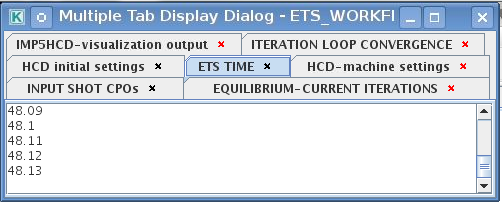
3.2.1.11.2. ETSviz
ETSviz is a python visualization tool with a graphical interphase that shows during the run the calculated kinetic profiles evolution, particle energy sources and sinks, equilibrium evolution and other useful infoirmnation. ETSviz appears automatically during the ETS run. If you would like to launch ETSviz you can find the script in $KEPLER/kplots
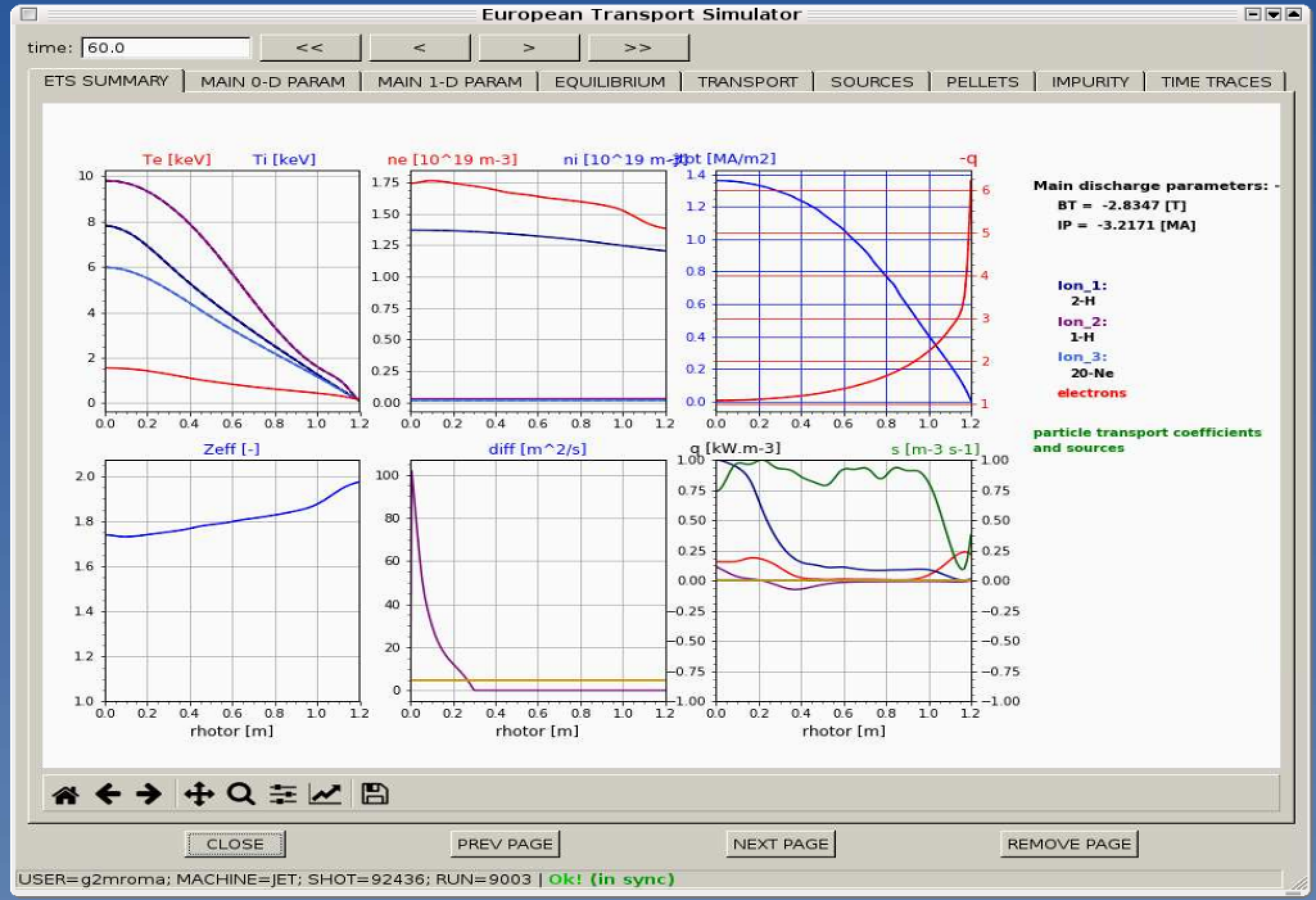
3.2.2. List of Actors
3.2.2.1. Equilibrium actors
Code name |
Code Category |
Contact persons |
Short description |
|---|---|---|---|
chease |
Grad-Shafranov
solver
|
Olivier Sauter |
Chease is a fixed
boundary Grad-Shafranov
solver based on cubic
hermitian finite
elements see
H. Lütjens, A.
Bondeson, O. Sauter,
Computer Physics
Communications 97
(1996) 219-260
|
emeq |
G-S solver
|
Rui Coelho |
fix-b equilibrium |
spider |
G-S solver
|
|
ASTRA fix-B equilibrium |
helena |
G-S solver
|
|
fix-B equilibrium |
spider_imp12 |
G-S dolver
|
|
ASTRA fix-b equilibrium |
3.2.2.2. Core transport actors
Code name |
Code Category |
Contact persons |
Short description |
|---|---|---|---|
BohmGB |
Bohm/gyro-Bohm
transport
coefficients
|
|
Analytical model |
CDBM |
CDBM
transport
coefficients
|
|
Analytical model |
Weiland |
Transport
coefficient from
fluid turbulence
|
Pär Strand |
Fluid model |
GLF23 |
Transport
coefficient from
drift wave
turbulence
|
|
Gyrokinetic model |
RITM |
Transport
coefficient from
drift wave
turbulence
|
Pär Strand |
Gyrokinetic model |
MMM |
Transport
coefficient from
drift wave
turbulence
|
PPPL |
Gyrokinetic model |
EDWM/EDWMZ |
Transport
coefficient from
drift wave
turbulence
|
Pär Strand |
multi-ion model |
nclass |
Neoclassical
transport
coefficients
|
Pär Strand |
Neoclassical model |
neos |
Neoclassical
transport
coefficients
|
Olivier Sauter |
Neoclassical model |
neowesz |
Neoclassical
transport
coefficients
|
Bruce Scott |
Neoclassical transport
coefficients based on
the expression in John
Wesson’s book Tokamaks.
|
neoartz |
Neoclassical
transport
coefficients
|
Bruce Scott |
|
spitzer |
Resistivity
|
Spitzer |
Resistivity model |
TGLF |
Transport
coefficient from
drift wave
turbulence
|
|
Gyrokinetic model |
NEO |
Transport
coefficient from
drift kinetic
equations
|
|
Gyrokinetic model |
QualiKiz |
Transport
coefficient from
drift wave
turbulence
|
|
Gyrokinetic model |
3.2.2.3. Heating and current drive actors
Code name |
Code Category |
Contact persons |
Short description |
|---|---|---|---|
gray |
EC/waves |
Lorenzo Figini |
GRAY is a quasi-optical ray-tracing code
for electron cyclotron heating & current
drive calculations in tokamaks.
Code-parameter documentation can be found
|
travis |
EC/waves |
Nikolai
Marushchenko
and
Lorenzo
Figini
|
Travis is a ray-tracing code for electron
cyclotron heating & current drive
calculations in tokamaks.
|
Torray-FOM |
EC/waves |
Egbert Westerhof |
Torray-FOM is a ray-tracing code for
electron cyclotron heating & current
drive calculations in tokamaks.
|
bbnbi |
NBI/source |
Seppo Sipila |
Calculate the deposition rates of neutrals
beam particles, i.e. the input source for
Fokker-Planck solvers (not the heating and
current drive). Note that the number of
markers generated by BBNBI is described by
the kepler variable number_nbi_markers_in.
|
nemo |
NBI/source |
Mireille
Schneider
|
Calculate the deposition rates of neutrals
beam particles, i.e. the input source for
Fokker-Planck solvers (not the heating and
current drive). Code-parameter
documentation can be found
|
nuclearsim |
nuclear/source |
Thomas Johnson |
Simple code for nuclear sources from
thermal/thermal reactions. Code-parameter
documentation can be found
|
afsi |
nuclear/source |
Thomas Johnson |
Complete code for nuclear sources from
all reactions. Code-parameter
documentation can be found
|
nbisim |
NBI, alphas/
Fokker-Planck
|
Thomas Johnson |
Simple Fokker-Planck code calculating the
collisional ion and electron heating from
a particle source, either NBI or nuclear.
Code-parameter documentation can be found
|
risk |
NBI Fokker-
Planck
|
Mireille
Schneider
|
Bounce averaged steady-state Fokker-Planck
solver calculating the collisional ion and
electron heating from a particle source
and the NBI current drive. Code-parameter
documentation can be found
|
spot |
NBI, alphas
and
ICRF Fokker
-Planck
|
Mireille
Schneider
|
Monte Carlo solver for the Fokker-Planck
equation. Traces guiding centre orbits in
a steady state magnetic equilibrium under
the influence of Coloumb collisions and
interactions with ICRF waves (through the
RFOF library). The code can also be used
for NBI and alpha particle modelling as it
can handle source terms from the
distsource CPO.
|
ascot4serial |
NBI, alphas,
ICRF/
Fokker-Planck
|
Otto
Asunta/
Seppo
Sipila
|
Monte Carlo Fokker-Planck solver
calculating the collisional ion and
electron heating from a particle source
and the NBI current drive.
|
ascot4parallel |
NBI, alphas,
ICRF/
Fokker-Planck
|
Otto
Asunta/
Seppo
Sipila
|
Monte Carlo Fokker-Planck solver
calculating the collisional ion and
electron heating from a particle source
and the NBI current drive.
|
Lion |
IC / waves |
Olivier Sauter
and
Laurent
Villard
|
Global ICRF wave solver. Code-parameter
documentation can be found
|
Cyrano |
IC / waves |
Ernesto Lerche
and
Dirk
Van Eester
|
Global ICRF wave solver. Code-parameter
documentation can be found
|
Eve
|
IC / waves |
Remi Dumont |
Global ICRF wave solver
|
StixReDist |
IC / waves |
Dirk
Van Eester
and
Ernesto
Lerche
|
1d Fokker-Planck solver for ICRF heating.
|
ICdep |
IC / waves |
Thomas Johnson |
Generates Waves-cpo with an IC wave field
with Gaussian deposition profiles
described by a combination of antenna-cpo
input and through code parameters input.
Code-parameter documentation can be found
|
ICcoup |
IC / coupling |
Thomas Johnson |
Simple model for the coupling waves from
ion cyclotron antennas to the plasma.
Code-parameter documentation can be found
|
3.2.2.4. Events actors
Code name |
Code Category |
Contact persons |
Short description |
|---|---|---|---|
pelletactor |
pellet |
Denis Kalupin |
|
pellettrigger |
pellet |
Denis Kalupin |
|
sawcrash_slice |
sawteeth |
Olivier Sauter |
|
sawcrit |
sawteeth |
Olivier Sauter |
|
runaway_indicator |
runaway |
Roland Lohneroch Gergo Pokol |
Indicating the presence of runaway
electrons:
1) Indicate, whether electric field is
below the critical level, thus runaway
generation is impossible.
2) Indicate, whether runaway electron
growth rate exceeds a preset limit. This
calculation takes only the Dreicer runaway
generation method in account and assumes a
velocity distribution close to Maxwellian,
therefore this result should be considered
with caution. The growth rate limit can be
set via an input of the actor. Limit value
is set to \( 10^{12} \) particle per
second by default.
(This growth rate generates a runaway
current of approximately 1kA considering a
10 seconds long discharge.)
|
3.2.2.5. Non-physics actors
The ETS uses the following list of non-physics actors: addECant, addICant, backgroundtransport, calculateRHO, changeocc, changepsi, changeradii, checkconvergence, controlAMIX, coredelta2coreprof, correctcurrent, deltacombiner, emptydistribution, emptydistsource, emptywaves, eqinput, etsstart, fillcoreimpur, fillcoreneutrals, fillcoreprof, fillcoresource, fillcoretransp, fillequilibrium, fillneoclassic, filltoroidfield, gausiansources, geomfromcpo, hcd2coresource, ignoredelta, ignoreimpurity, ignoreneoclassic, ignoreneutrals, ignorepellet, ignoresources, ignoretransport, IMP4dv, IMP4imp, importimptransport, itmimpurity, itmneutrals, merger4distribution, merger4distsource, merger4waves, nbifiller, neoclassic2coresource, neoclassic2coretransp, parabolicprof, plasmacomposition, PowerFromArray, PowerModulation, profilesdatabase, readjustprof, sawupdate_slice, scaleprof, sourcecombiner, sourcedatabase, transportcombiner, transportdatabase, wallFiller and waves2sources.
3.3. Turbulent Flux Quantities in Transport Models
3.3.1. Overview
In conventional transport modelling, all quantities appearing in the equations are 1-D, in some radial coordinate (poloidal flux, normalised radius, etc). In general any monotonic radial coordinate is acceptable. In the TF-EU-IM, the toroidal flux radius is standard. All we need from the radial coordinate is the transformation to get to \(V,\) the volume enclosed by the flux surface, which is fundamental to the governing equations, which are conservation laws.
What we have to do is to take a measured result, which is a time-averaged fluctuation-based transport flux and turn it into 1-D quantities suitable to modelling. This is done using the flux surface average, explained in conventions. The transport equations themselves constitute a mean field approximation to the 3-D conservation laws. For the fundamentals encountered in transport modelling see R Hazeltine and J Meiss, Plasma Confinement (Addison-Wesley, 1992) chapter 8. For the special properties of transport driven by small-scale pressure driven ExB microturbulence see B Scott, “The character of transport caused by ExB drift turbulence,” Phys Plasmas 10 (2003) 963-976.
For ambipolarity we follow the rules for dynamical alignment, which follows the physics of how electron fluctuations determine the ExB velocity fluctuations, which then advect all species. Magnetic flutter nonlinearities act independently of this, but in our modelling they are used solely for heat fluxes since the averaged particle transport due to magnetic flutter and the current cancels, leaving the parallel ion velocity which we neglect for this purpose. The reference for dynamical alignment is B Scott, “Dynamical alignment in three species tokamak edge turbulence,” Phys Plasmas 12 (2005) 082305.
Note: there are now auxiliary actors provided for this purpose: IMP4DV, which does the D/V conversion and enforces ambipolarity assuming absence of impurities, and IMP4imp, which subsequently enforces ambipolarity for the set of main ion and impurity species. The IMP4DV actor should be invoked directly after the transport model actor in the workflow chain, if the model produces only fluxes or if the coefficients have to be modified with the flux given. Ambipolarity is done using IMP4imp if the coreimpurity CPO is used in the workflow.
3.3.2. Particle Flux as an Example
The mean field equation governing particle balance is the transport equation for electrons,
in which the tilde symbol over the n and v denotes fluctuating quantities and we neglect all transport processes except ExB eddy diffusion. The ExB velocity is given by
where \(\phi\) is the electrostatic potential.
The angle brackets denote the flux surface average, and we will use the property that the flux surface average of a divergence of a vector is the volume derivative of the flux surface average of a contravariant volume component of the vector, in this case
where \(\Gamma\) is the particle flux whose flux-surface averaged volume component is
This is converted to expression in terms of the radial coordinate ( rho` using the fact that both \(V\) and \(\rho\) are flux quantities whose gradients are parallel to each other. We have
so we can write the transport equation as
where we have replaced \(\langle n \rangle\) with \(n\) following the assumptions of the 1-D version of mean field transport theory.
With all quantities now expressed in terms of flux quantities, we are free to characterise the transport flux \(\langle \Gamma^\rho \rangle\) in an arbitrary way, so long as only flux quantities appear. The flux expansion within the flux surface as well as expansion or contraction of surfaces of constant \(\rho\) is treated using the metric coefficient \(g^{ \rho \rho}\) which is dimensionless. This way we can characterise transport in terms of an effective diffusivity and an effective frictional slip velocity which are given in SI units. By convention both of these are done solely via \(g^{ \rho \rho}\) for convenience, also reflecting that the effective velocity is actually marking off-diagonal diffusive elements. Our convention for this follows the ETS code and is given by
So despite the special spatial distribution of any particular transport process (ie, the underlying instability or nonlinear free energy access), the flux-surface averaged flux itself and its expression in terms of diffusion and frictional slip are identical characterisations.
3.3.3. Metric Coefficients
Transport modellers want the Ds and Vs as physical quantities in SI units. In general the fluxes are (magnetic) flux surface averaged quantities, which implies the existence of metric elements in the conversion. In our case we need \(\langle g^{\rho \rho} \rangle\) where \(\rho\) is the toroidal flux radius in meters, so the metric elements are dimensionless. In the equilibrium CPO, this is gm3 under equilibrium%profiles_1d in the structure.
Note this is different from the ASTRA code which casts the Vs as proper velocities, i.e., with one factor of grad-rho given by \(\langle \sqrt{g^{\rho \rho}} \rangle\) which is gm7 under equilibrium%profiles_1d in the structure. The units are the same and the informational content is the same, but this difference has to be taken into account in any transport modelling and benchmarking.
3.3.4. Heat Fluxes
The heat flux is treated in a similar way, with transport equation
for electrons, with \(T_{ei}\) giving the species transfer and \(Q_e\) the source. For ExB transport the heat flux has a advective (also called convective) and a conductive piece given by
which appears with a 3/2 due to the Poynting cancellation. For magnetic flutter transport the advective piece appears with the usual factor,
Here the forms are given for each species and \(E\) and \(m\) refer to the ExB eddy and magnetic flutter channels, respectively. For reasons given below we are neglecting the magnetic flutter piece \(\Gamma_m\) for the time being, and then the flutter piece merely adds to the heat diffusivity.
The forms of these due to the fluctuations are then
which breaks into advective and conductive pieces according to linearisation of the pressure fluctuations
hence the density fluctuation piece is accounted for by the particle flux. Neglect of the magnetic flutter advective piece (and particle flux) is the same as neglect of the \({\widetilde u_\parallel} {\widetilde b^ \rho}\) nonlinearity (in the delivery of the results, not in the turbulence computations themselves).
The total conductive flux is then represented by
with \(\chi\) and \(Y\) giving the heat diffusion and frictional slip pieces for each species, respectively (these are in diff_eff and vconv_eff in the CPO for each quantity).
Operationally, the turbulence module communicates the diff_eff and vconv_eff due to each transport channel for each species to the transport solver, and the metric coefficients are used by both modules. The two modules can be on arbitrarily different grids, which communicate through standard interpolation. This despite the fact that transport at the micro-level is angle dependent (in general, it can be 3-D in the time average if the sources are 3-D). The effective transport is 1-D so long as parallel sound transit within the flux surface remains fast compared to the local transport time. This breaks down anyway in the edge, so the fact that the volume is a problematic coordinate and the flux surface average is a problematic operation on open field lines doesn’t enter.
3.3.5. Ds and Vs from Turbulence Codes to Transport Solvers
To serve the results from turbulence codes to transport solvers, we have to turn the fluxes (results) into diffusivities and effective velocities (coefficients, Ds and Vs for short), which represent more information than is at hand. Transport solvers must work with Ds and Vs because they use implicit schemes. The matrix must be diagonally dominant; hence one cannot simply use the Vs. Fluxes which are zero and/or negative should be given with positive diffusivities for the solvers to work. We need a set of rules to provide this.
Considering the particle and heat transport fluxes for a given species, we convert the gradient in to a logarithmic derivative and express the flux in terms of a specific flux, which has units of velocity,
wherein the conductive part of the heat flux (without the \(3 \Gamma / 2\) enters.
The choice of what to do with the Ds and Vs is somewhat arbitrary. The needs of implicit transport solvers is for a positive D regardless of the value or sign of either flux. We decide this by putting a limit on the effective Prandtl number or its inverse: the larger specific flux is taken to be entirely diffusive, with the effective velocity set to zero. Furthermore, to address cases with very small or negative gradients, we use proxy variables for the scale lengths to calculate the provisional diffusivities before using the Prandtl number limitation to turn these into actual diffusivities. Finally, the rest of the flux is asigned to the effective velocity, so that the D and V formula reflects the actual specific flux.
The Prandtl number limitation is expressed as follows. If the smaller specific flux is within a factor of 5 of the larger, then both are purely diffusive and the effective velocities are both zero. If not, then the D ratio is set to 5, with the result that the smaller D, having been corrected, is accompanied by the corresponding V, which is now nonzero. The specific flux with the larger D will be returned with a V which is zero.
The rationale is that the turbulent mixing by the ExB velocity affects all processes, but that linear forcing can shift the average phase shift of the fluctuations such that the effective flux can be small or negative. The simplest example is adiabatic electrons, for which the ion heat flux is robust but the particle flux is zero. In most situations the specific heat flux will be the larger, and hence the familiar situation is that of a D and V for the particle flux but a D (the chi) only for the conductive heat flux.
The full algorithm starting with the specific fluxes appears as
and all four elements are set. Note that the channels are done in parallel except for the Prandtl correction, in which the Max’s are taken sequentially. For the provisional diffusivities, absolute values are used to ensure positive values which are needed by transport solvers.
Note how in the end the actual gradients are used. If the gradients are moderate then their actual values are used, and if the Prandtl correction is not invoked, then both channels are diagonal. In any case the full relation is used to get the effective velocities (V and Y) so having set the rules to handle the arbitrariness of the diffusivities (D and chi) to guarantee reasonable diagonal dominance in a transport solver, the D’s and V’s agree with the fluxes themselves.
If there are more than two specific fluxes per species to consider, then we treat each scale length separately as above and use N-way maxima in the Prandtl correction for the N channels.
3.3.6. Ambipolarity
There remains the issue of ambipolarity of the D and V for particle flux. For a pure singly charged plasma the ion and electron Ds and Vs should be equal. Even if the turbulence model is gyrokinetic or gyrofluid, in which case the gyrocenter charge density is not zero but is equal to the generalised vorticity (polarisation), the quantities given to a transport solver should follow the rules for a fluid representation. However, transport modelling usually applies ambipolarity rules to the electrons after computing the ions, while the action of turbulence is actually the other way around: Dynamical alignment refers to the process by which (1) electron parallel dynamics controls the electrostatic fluctuations, then (2) the resulting ExB velocity advects all species equally. So we correct the particle fluxes by assuming the electrons determine the D according to the above procedure and then (1) the fluctuations in the flux-inducing part of the spectrum for the logarithmic densities are the same, and (2) the D’s are the same. Then the V’s are solved for again, by taking
This is better than the transport modelling convention but will give them the same information in a different way, and they will compute ambipolar particle fluxes (radial transport of charge is zero).
3.3.7. Statistical Character
Turbulence has a statistical character, so convergence to a mean is not monotonic and when within one std dev of the mean there is no further convergence. The diffusivity for ExB turbulence is comparable to
where \(\varpi_E\) is the ExB vorticity fluctuation, and these angle brackets denote the ensemble average. To get an ensemble average over a statistical quantity in practice, one must do some sort of finite-time running averaging.
For transport modelling, the transport coefficients derived from a turbulence code should always be given in terms of running exponential averages.
3.4. Running Exponential Average
3.4.1. Overview
In conventional transport modelling, turbulent fluxes are modelled in terms of processes which are diffusive in the local relaxation sense, with the average flux given by a diffusion coefficient and an effective pinch velocity. The equations are of dominantly parabolic character, which means in practice that an iterate will move monotonically towards the solution in parameter space.
This is not the case for turbulence. Convergence is statistical, which is something different than a diffusive relaxation. If turbulence is stationary, it is meant only that the mean of a distribution of iterates is stationary, not the iterates themselves. The standard deviation can be significant, of order unity compared to the mean, of any distribution of iterates.
This makes for a noisy signal if the output of a turbulence code is used for transport coefficients in a workflow. A sound way to overcome the attendant problems is to use a moving average. Even an average over a moving window can be as noisy as the original signal, however. What works better is a weighted average over recent past values. A method to get this is called a running exponential average, which is essentially the same thing as a convolution integral over an exponential memory decay times the past signal. It turns out to be very easy to obtain this without saving past values.
The original reference for the following is S W Roberts, “Control Chart Tests Based on Geometric Moving Averages,” Technometrics 1 (1959) 239-250, cited by all the good WWW resources, including the Wikipedia page on Moving Averages and the NIST Statistical Handbook online.
3.4.2. Definition
Consider a process \(p ( \vec u )\) which is a functional of dependent variables \(\vec u\). Measure \(p\) at discrete time intervals \(t_n,\) with values \(p_n=p(t_n)\) and interval length \(\tau=t_n-t_{n-1}\). The moving exponential average \(A_n=A(p_n)\) on the \(n \hbox{-th}\) interval is defined as
in which the small parameter \(\epsilon\) is given in terms of the interval \(\tau\) and an inverse time constant \(\alpha.\)
In the first instance \(p\) is measured there is no \(A\) so the first value of \(A\) is simply set to \(p\) since it can be assumed that the initial state for \(p\) has persisted for infinite previous time up to the initial time point.
3.4.3. Differential Equation
The equivalent differential equation is found by forming the relevant finite difference,
which we can also cast as
Taking the limit \(\tau \to 0\) is the same as taking \(\epsilon \to 0\) so both of these expressions become equivalent to
whose solution is given below.
3.4.4. Equivalence to Past-Time Convolution Integral
The solution of the above differential equation is given by the method of undetermined coefficients,
We may integrate this over all past time, to find
This is a convolution integral over the kernel \(e^{-\alpha(t-t')}\) and the signal \(p(t')\). The time constant \(\alpha^{-1}\) is just the memory decay time, while if \(p\) is constant then the integral yields unity times \(p\). This is the same as the normalisation with the \((1-\epsilon)\) factor in the average formula above, which is needed since the interval is of finite size.
Hence the running exponential average is operationally the same as a memory decay integral over past time. The elegant feature is the need to keep only the current value of \(A\), as it already contains all that is needed of the past time evolution of \(p\).
3.4.5. notes
Some properties of the running exponential average and how to choose its main time-memory parameter:
The \((1-\epsilon)\) factor is needed for normalisation
if \(p=\hbox{constant}\) then \(A=p\) for all \(t\)
the integral with \(\alpha dt'\) yields unity
the \(\epsilon\) and \((1-\epsilon)\) factors add to unity
therefore set the first value of \(A\) to the first value of \(p\)
in choosing the memory decay time \(\alpha^{-1} \dots\)
one should have \(\alpha \tau_{cor} \ll 1\)
best results are for \(\alpha \tau_{sat} \sim 1\)
some trial/error required; edge turbulence likes \(\alpha^{-1}=200 L_\parallel / c_s\)
In these expressions \(\tau_{{cor}}\) and \(\tau_{{sat}}\) are the correlation and saturation times of the turbulence, respectively.